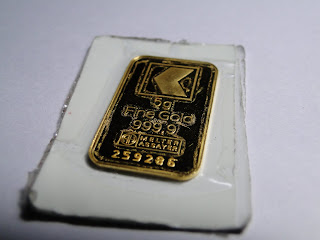Different people value gold in different ways and has lot meaning to them, some are emotionally attached to their gold while some might hate it, some use it a investment even as a currency too.
Since young I did not have any affinity and liking for gold. Many people have presented gold ring and chains to me but I always end up giving it to others. Only recently realized the true value of gold and started to learn more about this precious metal and come to realize that gold is the real money and all those man made moneys that are circulating are fake money! I was really ignorant about it and this truth is not thought in any schools and no one has talked about it. This is a hidden secret kept by those who knew it! While the poor although value this precious metal but, only as jewelry with emotion attached. We never considered it as a investment to get richer and the most importantly as a alternative currency (true money).
The only experience I had is when my family pawn gold for quick cash! Although this a better than borrowing money from someone else or from loan shark!, it only got us poorer! Gold when pawned will become a liability not an asset! Because it take money out of your pocket. The riddle is how to make gold to put money into your pocket thus becoming an asset for you. If you keep many jewelries but if it did not put money into you pocket it is still not an asset. Yes of course you can sell it to gain cash but it still not an asset until you sale it which many would not due to emotions attached to it.
So how to get more value out of gold? Well as for me gold should be use to bit inflation and to offset declining value of our currencies. The golden question is how to turn you money into something more value, instead spending and making your cash into a trash. Yes cash is trash!
Well if you are thinking on "investing" in gold - for cash!, What are gold-advocates doing investing in gold, or even worse, trading in gold, when all they will get out of it is what they already know will soon be worth less?
Cash is trash. If you're angling for cash, you are asking to crash.
If you "invest" (medium to long term) in gold, you'll get back trash.
If you "trade" (short term) in gold, you'll get back what soon will be trash.
Only if you buy and hold physical gold will you get value in exchange for trash.
Which one is the better bargain?
Yes, of course, cash is what we pay our bills with, so we all need it. But accumulating physical gold is the absolute best way to deal with the current (and future) situation. All currencies will depreciate against gold.
You work to make money. You spend what you need to spend, and the rest you use to buy gold. Do this every month, from now on. When you lose your job or need to liquidate some gold because you don't have enough trash to buy whatever you need in the future, liquidate only what you need, and keep building your "hoard" whenever you can.
By all means, buy some good gold and silver stocks, too - especially of companies that keep metal on reserve instead of cash. Maybe invest in a gold ETF. But make physical your mainstay. That way, you build value. If you don't trade gold, you deprive the enemies of gold of their number-one weapon.
And, what's more, you don't get wobbly knees every time gold dips a bit because some CB official somewhere is spitting hot air at the markets.
Currencies are in a downward spiral; even the "strong ones" will eventually follow. The dollar is no longer as pivotal to the world monetary system as it once was only a few years ago. Because of that, gold is no longer as "repressed" as it once was. It is still being "managed", to be sure, but the direction is now slowly upwards. It is no longer being suppressed at all costs.
That's why gold is not an "investment". It needs to be held for its own sake, not to make a stash of trash.
A suggestion: if your fingers are itchy, and you just have to trade something because it's so exciting, trade stocks. That way, at least you won't play into the hands of the bullion and central banks in their attempts to make gold look like trash - for the time being.
Then, if you're lucky and win in the stock-trading casino, take your winnings off the table and put them into gold. Physical gold, that is. But, when it comes to gold itself, the best advice is:
Don't trade it.
Don't "invest" in it.
Just buy it!
Got gold? Get gold! Go gold!














